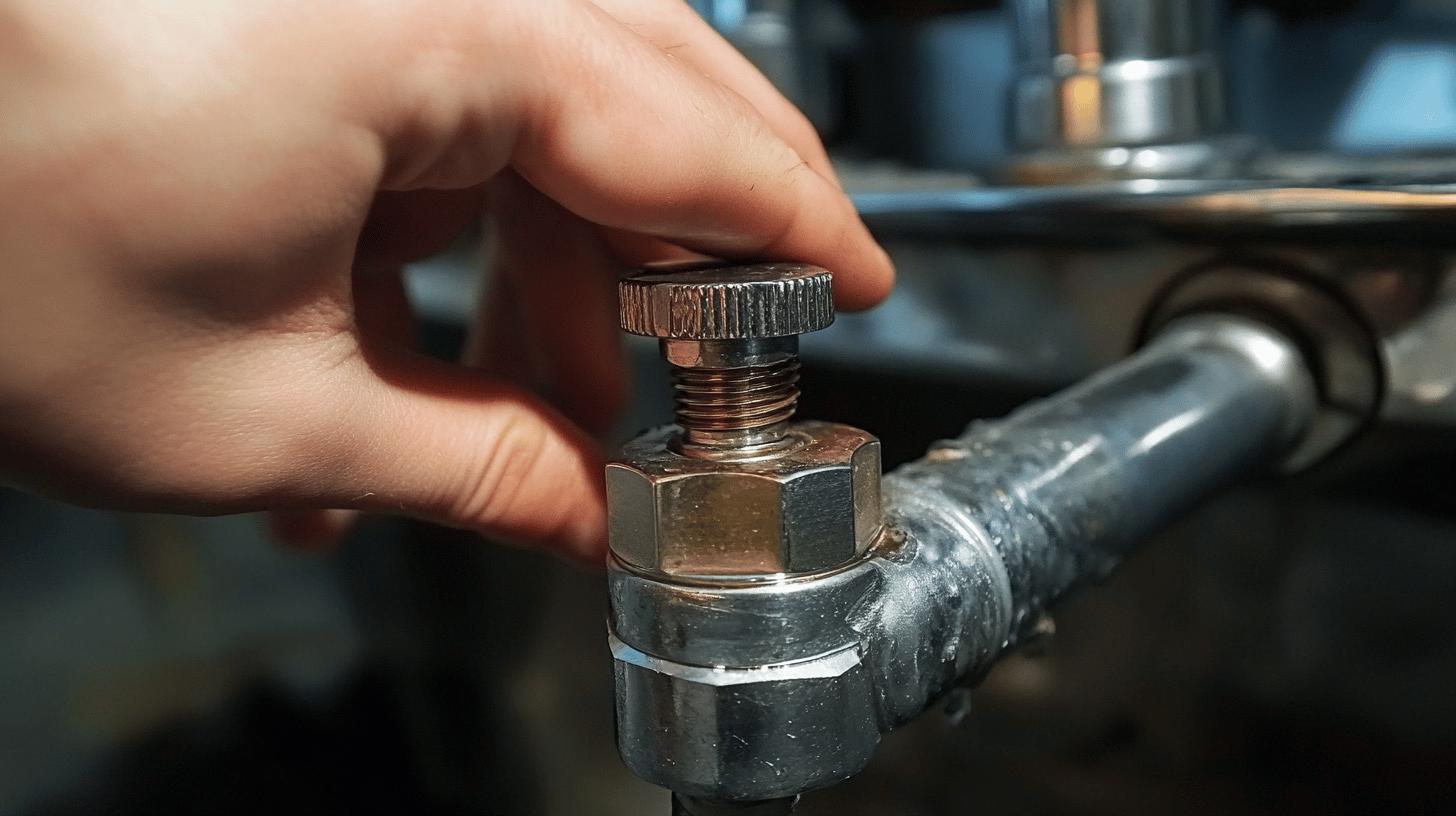TL;DR:
- Location of Shut-off Valve: Usually near the toilet base, either on the wall or floor; often football-shaped.
- Steps to Shut Off Water:
- Locate and turn the valve clockwise.
- Use lubricant if difficult to turn.
- Check for leaks post shut-off.
- Types of Valves:
- Push-on (moderate durability).
- Compression (high durability).
- Quarter-turn (very high durability).
- Troubleshooting Issues: Look for damage, tighten connections, apply lubricant, and replace seals if leaking.
- When to Replace: Corrosion, leaks, or operational difficulties indicate the need for replacement.
- Consider Professional Help: Ensure proper installation to avoid leaks and plumbing issues.
Knowing how to spot and fix a leaking water shut-off valve can save you from expensive repairs and water damage. This guide covered important areas to check for leaks and offered simple DIY solutions like tightening the packing nut or replacing a washer.
While DIY fixes are helpful, it’s important to know when to call in professionals for more complicated leaks. Regular maintenance is key to preventing issues and keeping your plumbing running smoothly. By staying proactive, you can protect your home and ensure your water system remains reliable.
Locating the Water Shut Off Valve for Your Toilet
Finding your toilet’s water shut-off valve is essential for handling plumbing issues or maintenance. Typically, these valves are located near the base of the toilet, either on the wall or the floor. They are often football-shaped and connected to a pipe leading to the wall. Most toilets have a built-in shut-off valve in the tubing that connects to the water tank, allowing you to control the water flow just to the toilet without affecting the main water supply to the house.
To find your toilet’s shut-off valve, follow these steps:
-
Inspect around the toilet base: Check the wall or floor for a valve connected to a small pipe.
-
Identify the valve shape: Look for a football-shaped valve for quick identification.
-
Check the connection: Make sure the valve attaches to the pipe leading to the toilet’s water tank.
-
Look behind or beside the toilet: Some valves may be slightly hidden, so a closer inspection might be needed.
-
Check plumbing plans: If the valve isn’t visible, your home’s plumbing blueprints may help locate it.
In warmer climates, the shut-off valve may be located outside. Look for an iron box with a lid in the ground, which might also cover the water meter. The placement of the valve can vary depending on your home’s design, so familiarizing yourself with your home’s plumbing layout will help you quickly locate it when needed.
How to Shut Off the Water Supply to Your Toilet

In emergencies or during maintenance, turning off the water supply to your toilet can prevent major water damage and plumbing problems. It’s essential to shut off the water before making repairs or fixing leaks. This stops water from flowing into the toilet, allowing you to work safely and efficiently.
To shut off the water to your toilet, follow these steps:
-
Locate the shut-off valve: Find it near the toilet base, usually on the wall or floor, and often football-shaped.
-
Turn the valve clockwise: Rotate it until it stops to close the valve and halt the water flow.
-
Use lubricant if needed: If the valve is hard to turn, use WD-40 or similar to ease the movement. Avoid forcing it to prevent damage.
-
Check for a complete shut-off: Listen for water. If it’s still running, the valve may not be fully closed.
-
Inspect for leaks: After closing the valve, check around it and under the toilet for leaks to ensure a secure shut-off.
-
Seek help if stuck: If the valve doesn’t turn or shows rust, consider calling a plumber for a replacement.
Once the water is turned off, flush the toilet to empty the tank and confirm the water supply is disconnected. The tank shouldn’t refill. If it keeps running or leaking, further inspection or professional help might be necessary. Regularly checking the valve helps prevent emergencies and keeps things running smoothly.
Types and Features of Toilet Shut Off Valves
Toilet shut-off valves control the water flow and come in different types and materials, each with its own set of benefits. Common types include push-on valves, compression valves, and quarter-turn valves. Push-on valves are simple to install without tools, though they may leak if not secured properly. Compression valves, on the other hand, provide a secure fit but require tools for installation. Quarter-turn valves are easy to use, offering a quick shut-off with minimal effort.
When it comes to materials, brass valves are generally more durable than plastic, offering a longer lifespan and better resistance to wear. Some valves come as one-piece units that combine the shut-off valve and supply line, reducing the risk of leaks. However, separate valves and supply lines offer more flexibility when it comes to replacements.
| Valve Type | Features | Durability |
|——————|————————————————–|————————-|
| Push-on | Tool-free installation, easy to use | Moderate, can leak if not installed correctly |
| Compression | Secure fit, requires tools | High, reliable connection |
| Quarter-turn | Simple operation, fast shut-off | Very high, durable and user-friendly |
Choosing the right shut-off valve depends on what you need. If you want something easy to install, push-on valves might work, but make sure they’re securely fitted. Compression valves are more durable, though you’ll need some tools to install them. Quarter-turn valves are super easy to use and reliable. Also, think about the material—brass is the best for long-lasting use, especially if your water quality could cause wear. Look at your plumbing setup and needs to pick the right valve.
Troubleshooting Common Toilet Shut Off Valve Problems

Toilet shut-off valves can run into problems like leaking or being hard to turn. Leaks usually happen because of worn seals or poor installation, which can cause water to leak from the handle or valve body. If the valve is stiff to turn, it could be due to rust or mineral buildup. Regular use and maintenance can help prevent this. When issues come up, it’s important to address them right away.
Here are some troubleshooting tips for toilet shut-off valves:
-
Look for damage: Inspect the valve for cracks or corrosion which might require replacement.
-
Tighten connections: Ensure all connections are tight, but avoid over-tightening, which can damage parts.
-
Apply lubricant: Use a product like WD-40 to ease stubborn valve movement, but don’t force it if stuck.
-
Replace seals: If leaks continue, change worn seals to stop leakage from the handle or valve body.
-
Conduct regular inspections: Check regularly for wear or rust to prevent bigger problems later.
Knowing when to call a pro is important. If the valve stays stuck or leaks after trying to fix it, it’s time to get a plumber to prevent water damage and make sure the problem is solved correctly. Plumbers can tackle tougher issues and provide lasting fixes, so you won’t face the same problem again. Regular maintenance also helps keep the valve working longer and more reliably, so it’s a smart habit to get into.
Replacing Your Toilet Shut Off Valve: When to Call a Professional Plumber
You should replace your toilet shut-off valve if it shows signs of corrosion, leaks, or becomes difficult to turn. These issues can mess with your plumbing system and lead to water damage if not fixed. Regularly checking the valve helps catch problems early, so you can replace it in time and keep your water control running smoothly.
Avoid common DIY mistakes during valve replacement:
-
Not shutting off water: Failing to turn off the main water supply can lead to uncontrolled flow and flooding.
-
Improper fitting: Using the wrong size or type of valve can cause poor sealing and leaks.
-
Over-tightening: This can crack parts or strip threads, weakening the installation.
- Ignoring leaks: Not testing the valve after installation can let leaks go unnoticed, causing damage.
Hiring a professional for installation ensures everything is done right, cutting down the chances of leaks and plumbing problems. They have the tools and skills for more complicated tasks. While it may cost more at first, professional installation often saves you from mistakes and expensive repairs later. It gives you peace of mind knowing your plumbing is in good hands and helps your system last longer and work better.
Final Words
Finding and using your toilet’s water shut-off valve doesn’t have to be stressful with the right info. You now know where to locate the valve, how to turn off the water supply, and what to look for in different valve types. With troubleshooting tips, you’re ready to tackle common issues and know when it’s time to replace the valve. If you’re unsure, getting a professional to install the valve can save you time and worry, ensuring your plumbing stays in top shape. With these solutions, you’ll have a smoother experience managing your toilet’s water supply.
FAQ
What kind of shut-off valve do I need for a toilet?
You need a shut-off valve that is durable and easy to use. Common types are push-on, compression, and quarter-turn valves. Brass materials are often preferred for their durability and reliability.
How do I turn off the water supply on my toilet?
To turn off the water supply on your toilet, locate the shut-off valve near the base and rotate it clockwise until it stops. If it’s hard to turn, use a lubricant.
Where is the water shut-off valve for my toilet?
The water shut-off valve is located along the tubing connecting to your toilet’s water tank. It is typically near the base on the wall or floor, shaped like a football.
How much does it cost to replace a toilet water shut-off valve?
Replacing a toilet water shut-off valve typically costs between $50 and $150, depending on the complexity of the job and labor rates in your area. Hiring a professional may increase the cost.

